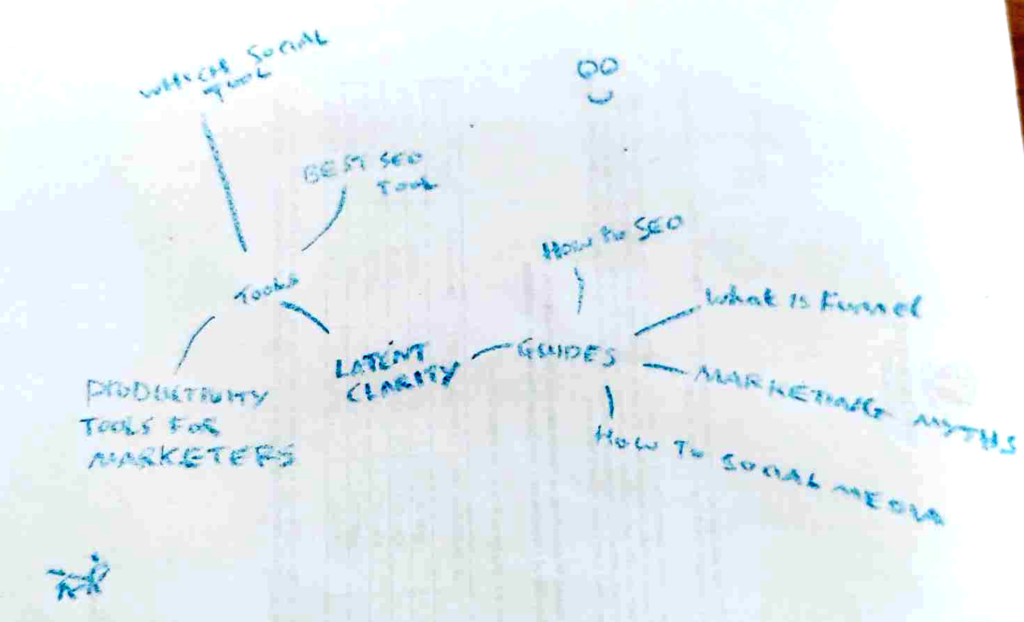
This article literally teaches you how to do SEO. Trust me, it’s easier than you think!
This article is longer than a Lord of the Rings marathon, so do skip ahead if you feel the need:
Otherwise, let’s get cracking. 🍳
Let’s start with the super basic: SEO = Search Engine Optimisation.
In simple terms, it’s the collective name for a bunch of practices which aim to manipulate search results to show your web pages as high up the results page as possible. Preferably for searches that are actually relevant to your business.
These are called Rankings and are the bread and butter of an SEO strategy.
Why? Because people who click on your search results and visit your website are essentially free visitors. Unlike ads, they haven’t cost you a penny, so the return on investment (ROI) can be excellent.

I want to get some key terms out of the way before we delve into this:

Nice, there are some new words for your mental dictionary 🤓. That’s going to help you make sense of the rest of this article, so buckle up and let’s learn some SEO.

Broadly speaking, SEO activities fit within one of three columns: 🏛️
Honourable mention for Local SEO, which kinda straddles On-Page and Off-Page.
Doesn’t seem that bad when you break it down like that, huh?
I’m actually going to start with Technical, as it’s really the simplest to get right…
Don’t panic, this isn’t as scary as it sounds.

Technical SEO is literally just making sure your website works properly and is pleasant to use.
Here’s a video explainer if you can’t be bothered to read:
Google values websites which aren’t broken dumpster fires, as they provide a better user experience (UX). A better user experience loosely translates to better rankings, as your users stick around longer on your site and that tells Google your site is worth visiting.
If you’re a complete novice to this (and you probably are, given that you’re reading this), I recommend starting off with a tool like Ahrefs or Semrush. Their technical audit sections will do the heavy lifting for you and give you some nice, easy and understandable ways to improve your website.
You want more tools? Alright, go and see what I recommend for SEO.
If you’re curious about how these tools actually work, they basically click on every link in your website to find the pages, then look at the data on each page to find problems. Google reads your website using a very similar process.
Most often, simply redirecting broken pages to functional pages resolves a lot of the errors.
Take a note of any pages with too long, too short, or missing titles and meta descriptions. You’ll want them later for the On-Page section.
“Page speed” (how fast your web pages load) is also a factor here, so stick your URLs into Pagespeed Insights to get an idea of how fast your pages load on mobile and desktop.
Top tip: Pagespeed Insights will only give you speed data for the exact URL you stick in. As such, test a few different page types, like your homepage, a blog, a product/service page, a category page etc to get a good feel for the general speed of your site.
If you’re not a developer, you’ll probably struggle to make any meaningful changes to the speed of your website.
A good place to start is ensuring as many of your images are under 100kb as possible (without sacrificing too much quality). Pages load faster if the browser doesn’t have to download massive files, and images are the worst culprits.
There are loads of guides on how to optimise images, so I’m not going to write a new one.
At this point, you’ll have a technical audit report to look at and have an idea of how fast your website is.
You’ve probably fixed whatever your feel capable of fixing, so hand the rest of it over to a developer and let the pros fix it up.
That’s it, you’ve done technical SEO. Pat yourself on the back.

This one is a biggie, as it’s really where most of the optimisation part of SEO happens.
Google (and other search engines) look at many different factors when deciding if and how to rank a web page. Google looks at over 200, in fact.
You don’t need to know all of those. In fact, nobody does, other than Google.
The important ones are:
Right, back to On-Page SEO…
The first key element to optimising your site is having a decent site structure.
Websites are literally a series of folders sat on a computer somewhere called a server.
If you imagine a folder on your computer called “My Website”, inside that folder will be a bunch of files, and each file will make up a page on your site.
If you bother to organise your digital life, you probably nest your folders something like this:
If that was a website, it would be https://personalstuff.com. The Taxes folder would be at https://personalstuff.com/taxes.
The Holidays folder would be at https://personalstuff.com/family-photos/holidays.
Get it?

That makes a load of sense as a structure. Google really likes that. It finds it easy to navigate your site and it knows users will too.
Here’s a handy example from Semrush:

If you organise your website into folders, it will make a lot more sense.
If you’ve got a blog, have it live at website.com/blog. Any articles can then live at website.com/blog/article-url.
Products can live in categories. Such as website.com/vegetables/potato. 🥔
If you can read a URL and have a pretty good idea of:
A. What the page contains
B. Where you are in the website structure
You’re doing a grand job.

Content makes the world go round. In fact, it’s estimated 1.145 trillion MB of data is added to the internet per day. That’s a disgusting amount of information and you can bet your bottom dollar that most of it is garbage. 🚮
There seems to be a general assumption that if you put content on your website, it will somehow get ranked and people will visit. Sounds like Myth #4 to me.
In the real world, you’re competing against the other trillion MB of data that was uploaded that day. The chance of your content actually getting read is infinitesimally small.

Unless you write decent stuff and optimise it well.
Because, as I said, most stuff on the internet is godawful. So actually putting a bit of effort in goes a long way.
Most articles would probably dive into keyword research at this point, but I’m gonna save that for later. Why? Because one of the best ways to write good content is to not write for SEO.
This is one of the most important lessons in this article:Write for people, not for Google.
This is so important. Whenever you write, that should be the mantra sitting in the back of your mind.
If you can provide value to your readers, they will stick around for longer to read your content. Consequently, Google will think your website is actually worth visiting and is more likely to rank your content higher.
Here are five more guidelines to follow to help you write content that people actually want to read:

Top tip: If your blog posts are under 1,000 words, it probably isn’t providing any real value.
🫵 Now go and write some amazing content and come back when you’ve finished, ‘cos we’re not done here.
Told ya this was coming later.
Researching keywords is largely considered as brain-numbing. However, it’s a necessary evil, as you’ll struggle to actually optimise anything without it.
I’ll try to make it as easy as possible for you.
Start by deciding what you want to achieve. This comes back around to the funnel again. I go into that in this guide if you’re scratching your head.
Common goals may be:
Speedy explainer before we continue: “User intent” is the term for the intended goal of the person doing a search. Common users intents include the intent to know something, to buy something, to compare something etc.
Ultimately, depending on your goal, you want different types of keywords for different funnel stages and user intent:
If you already have great product/service pages, but you are struggling to drum up new visitors, try focusing on informational keywords and draw in users with great resources.
Conversely, if you have loads of visitors, but they tend to only visit your blog, try linking from your blog to your products/services and make sure your transactional pages are optimised for transactional keywords.
Ok, if you’ve now got a fair idea of of your goals and the corresponding user intents, you can start actually figuring out which keywords to target.
The first stage is to actually just start brain dumping 🧠

Let’s spin off an example for this section. If I was bothered about SEO for this website (which I’m not, sue me 🤷), my thinking would probably go a bit like this:

No, God. That’s terrible, don’t do that. 🤮
It is a good idea to make a mind map though, and put your main products and services around the edges. Just write down all the words and questions you and your potential customers associate with them and you’ve made your starting list.
Once you’ve got your list, I recommended sticking them in a spreadsheet. Google Sheets is a nice tool, but you might want to stick with Excel for this, as Sheets can get a bit bogged down by loads of data.
Now it’s time to boot up a keyword research tool. There are a handful of my favourite ones on the tools page. I’m not going to delve into how each tool works specifically, as they all vary and you could be using anything.
However, the general gist is that you paste your initial list into the tool and hit the “go” button. It will spit out hundreds to thousands of other keywords which it feels are relevant to your list.
Each keyword will have some associated metrics with it:
Those metrics will vary slightly between different tools, but they’re generally similar.
When you pasted your initial list of keywords into your tool, you’ll have got a list of these metrics to match each keyword. Export them and stick them in your spreadsheet.
Next to each keyword, type in your assumed search intent. Be consistent, as you want to be able to filter them later.
If you’re not sure of a keyword’s search intent, look at the CPC first (high CPC indicates transactional intent), and actually Google the keyword. If the SERP is full of blogs, it’s probably informational. If it’s full of products and services, it’s transactional.
Alright, you’ve made good progress so far in bulking out your initial list with supporting data.

Now we need to find the keywords which you haven’t thought of.
Go back to the your keyword research tool and have a look through the keywords it suggested as related to your list.
Depending on if you’re targeting transactional or informational terms, sort the list by CPC or Volume respectively. Pick through the related terms list and see if there are any you want to add to your spreadsheet.
Then add them, obviously! 😉
I bet you managed to bulk up your sheet quite a bit there. Nice going.
No matter how unique you think your product/service is, there is someone else out there doing the same or similar. These are your business competitors.
Equally, there are a load of web pages out there that are largely unrelated to what you do, but compete with your chosen keywords by chance. These are your search competitors.
Now it’s time to see what keywords they rank for, and maybe even steal a few.

Get a list of your competitor web addresses (domains). You probably already know your business competitors, but you can find your search competitors in Ahrefs or Semrush’s “Organic Competitors” reports.
Stick one of their domains into your keyword research tool’s site analysis section (Ahrefs and Semrush have these features also).
Somewhere in there will be a list of the keywords your competitor ranks for. Export the whole lot and stick them in a new tab in your spreadsheet.
Do this for as many competitors as you want.
While you’re there, stick your own website in there as well and export the keywords you currently rank for. Put them in their own tab in your spreadsheet.
This is a good time to bring up the “Content Gap Analysis” (Ahrefs), and “Keyword Gap Tool” (Semrush).
You can paste your competitor domains into these tools, and also your own domain. They will then spit out all the keywords your competitors rank for, but you don’t.
This is a great way to find obvious gaps in your content strategy. Don’t miss the party! 🥳
You can now see if your competitors are ranking for keywords that you could also rank for. Grab the best ones and put them into your main list with the accompanying data and user intent.
Ok, so you should now have a chonky spreadsheet with a few tabs:

You got the data, now we need to turn it into information.
Take your main list and whack it into a different spreadsheet. You’re going to want to split your list out into different categories.
The categories are up to you and your goals, but I tend to segregate my keywords by intent and by theme.
E.g. Filter your user intent column to only show transactional, and copy/paste them into a “transactional” tab.
Or if you’re going by theme, group them by related elements, like a specific product, or put all the question keywords in one tab.
There’s no right or wrong here. You just need to split them out in a way that makes sense to you for easier analysis. The goal here is to cut down that massive list into a series of smaller, manageable lists.
Make another tab called “Target keywords”. This is where the survivors of your analysis will end up.
I like to use heatmapping for this. Excel is a bit easier to use for this.

By the end of that, you will have lots of pretty colours across your columns and at a glance you can see which keywords have the most green. Those are probably good bets for your target list!
Make sure you Google the keywords you pick for your target list to sense check the data.
Fill out your target list tab from the lists you’ve analysed and you’re done.

If you’ve been following this guide closely, you’ve already written, or are planning to write some decent content for people, not Google.
Once you’ve written that content, you can start allocating your keywords to relevant pages/posts.
You’ll probably want to use another spreadsheet for this. 😁
List out all your content in one column, and list out the relevant keywords for each row in another column. It might help to categorise your content by funnel stage and user intent before allocating the keywords.
Now simply get in there and make minor edits to your content to fit in the keywords. Only put the keywords in where they fit naturally. Don’t cram them in and try not to repeat them too much.
General rule of thumb: If it sounds wrong reading it out loud, you shouldn’t put the keyword there.
Example: We sell the best wardrobes London.
That’s some terrible keyword placement. Don’t be afraid to break up the keyword a little to make it fit – “we sell the best wardrobes in London”. It’s largely the same as far as Google is concerned.
Try to keep each page to only a couple of main keywords and their close variations.
You’ll likely find afterwards that you have a few sad, orphan keywords without pages to live in.

These little guys are ripe for new content opportunities. Why not write some pages just for them. 👍
You can edit these in your page settings somewhere. Depends on your website Content Management System (CMS). On WordPress, install the Yoast plugin and you can then edit the metadata in the page editor.

The meta title should ideally include your page name and the target keyword for that page. E.g. “Latent Clarity | Empowering New & Solo Marketers”. Keep it under 60 characters to prevent it being cut off by small screens.
All bets are off for the meta description. It’s a marketing myth that the keyword needs to be included as a ranking factor.
Instead, focus on encouraging a search user to click. Provide a concise description of the page contents and a Call to Action (CTA), like “Get started today”. The total length should be under 160 characters.
Well that wasn’t too difficult.
That’s it for on-page. At least, at this level. Get those basics right, and you’re well on your way to having a well optimised website.
Keep reading and learning though, as there are many small techniques and strategies that I haven’t gone into here.
Extra credit is awarded to those who go away and Google schema markup, image optimisation and anchor link best practices. 🎓
Oh boy, we’re motoring now. If you’re still reading, good on you.

Off-page SEO is all about backlinks and authority.
Actually, backlinks give you authority. Let me explain.
Every time you get a link to your website from somebody else’s website, they are basically giving you an upvote. 👍
This “backlink” tells Google that whatever is on your website is good enough that somebody else wants to direct their own users to you.
This gives you authority in the eyes of Google.
Roughly speaking, the more links (upvotes) a page has, the more authority it has. If those links come from websites with even better authority, they carry even more weight.
In practical terms, more authority makes it easier to rank for the keywords on that page.
If two web pages were completely identical, but one had backlinks and the other didn’t, the one with links will likely rank better.
Here we go again with the science.
For you to actually measure this abstract concept of “authority”, you can use tools like Ahrefs, Semrush and Moz.
When you whack your domain into one of those tools, they will give you an indication of that domain’s authority from 0 – 100.
There are different names for this, depending on the tool:
It’s all the same, but as Google doesn’t actually tell anybody its own “authority score”, these tools roughly approximate it. They do this by comparing all the websites in their database and the links between them.
As such, the scores on each tool will differ slightly and none of them are gospel. They are indicative only.
Alongside your domain’s authority is the authority of each individual page on your site. Often called…drumroll 🥁…page authority.

This is also out of 100 and gives an indication of the backlink strength of that particular page. This is relevant as that’s actually more important than the DA when it comes to that page’s ranking potential for its target keywords.
General rule of thumb: A domain authority score of 30-40 usually means a site is competitive within its niche. 70+ is getting unattainable for mere mortals, and 80+ is really reserved for big boy sites like Facebook.
Also a helpful tip: DA is logarithmic. This means it’s much easier to get from 0-10 than 10-20 and so on. So next time someone moans at you to increase the DA, tell them to shove it. DA on its own is a useless metric. It’s the backlinks that actually matter.
Backlinks aren’t all equal.
In the same way that an endorsement from your CEO means a whole lot more than one from the delivery dude, more authoritative link sources carry more weight.
In that example, maybe the CEO has a DA of 80 and the delivery guy has a DA of 30. If you, as an employee, have a DA of 50, an endorsement from the delivery guy doesn’t really do much for you.
I’ve got nothing against delivery guys, by the way. 😐
Going back to reality, if your website has a 1,000 links from low DA blogspot blogs, a single backlink from a high DA source like medium.com could be worth more and boost your DA more noticeably.
The lesson here is that more links does not necessarily equal more authority. The links actually have to be from decent websites.
You can find out a website’s DA the same way you found out your own – with the SEO tools.
Links come in a couple of flavours – nofollow and dofollow.
Without bogging down in the technical side of this, by default, links are “dofollow”. This is good. It tells Google that the website hosting the link wants it to go and find out whose website is on the other end, and subsequently hand them some authority.
“nofollow” links are deliberately specified as such in the code. They basically tell Google to ignore the link. As such, no authority is given to the linked website.
Many news sources and larger publications will “nofollow” links by default, as this protects them from accidentally linking to low quality websites. This could damage their own reputation with Google, so they take a blanket approach.
In short, make sure any links you obtain for your site are “dofollow”. Your SEO tools will tell you which links are which in their backlink reports.
General rule of thumb is to shoot for at least 80% “dofollow” links in your overall backlink profile.
Welcome to the world of “linkbuilding”. A thorny quagmire of traps, dead ends and effort.

Here are some strategies you can employ to get good-quality links to your site:
Wonderful. That about sums up off-page SEO.
Congratulations 🥳, you now know the three pillars of SEO 🏛️. At least, the fundamentals.

BUT WAIT! One more thing…
You didn’t think I was going to let you leave without touching upon local SEO did you?
What? You didn’t know about it? I guess that makes sense, given that you’re here. ¯\_(ツ)_/¯
This doesn’t get its own pillar, as it really stems from techniques in both off and on-page.
Local SEO helps you to get found in your local area. It’s most applicable for businesses which have real, physical locations that people can visit.
Here’s a whistlestop tour of the things you should be doing to improve your local presence:

Ok, now we’re done.

Armed with everything you just learned, you can confidently go and do some SEO.
SEO is a massive topic and it would be remiss of me to say that we’ve covered everything in the last *checks* 5,909 words, but we’ve had a good stab at the foundations.
It’s up to you now, my young padawan. Go out into the galaxy and chart your own course. Show me that the student can become the master.

Sorry, we went very Star Wars there, for some reason.
If you want to read more ridiculously long articles like this, you might as well finish this episode by sticking your email in the box below. I’ll occasionally send you the Clarity newsletter with more crazy stuff like this. No spam, just GOLD 🪙.
Founder of Latent Clarity and author of the Clarity newsletter.
I help new and solo marketers be the best they can with practical, actionable, (and sometimes funny) advice.